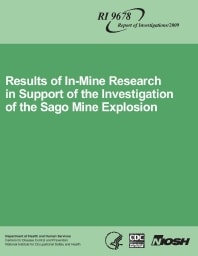Mining Publication: Results of In-Mine Research in Support of the Investigation of the Sago Mine Explosion
Original creation date: September 2009
Authors: KL Cashdollar, ES Weiss, SP Harteis, MJ Sapko, JE Urosek
NIOSHTIC2 Number: 20035928
Pittsburgh, PA: U.S. Department of Health and Human Services, Public Health Service, Centers for Disease Control and Prevention, National Institute for Occupational Safety and Health, DHHS (NIOSH) Publication No. 2009-168, Report of Investigations 9678, 2009 Sep; :1-136
The Mine Safety and Health Administration (MSHA) and the West Virginia Office of Miners Health, Safety, and Training (WVOMHS&T) investigated the explosion at the Sago Mine in West Virginia, which occurred on January 2, 2006, and resulted in 12 fatalities. As part of the investigation, the agencies requested that the National Institute for Occupational Safety and Health's (NIOSH) Pittsburgh Research Laboratory evaluate the effects of explosions on specific mine ventilation seals and other structures and objects at its Lake Lynn Experimental Mine (LLEM). The results of the LLEM study would assist MSHA and WVOMHS&T in a more thorough understanding of the various questions that arose during their investigations of the explosion. Six large-scale explosion tests were conducted in the LLEM from April to October 2006. The protocols for these tests, and in particular the procedures for constructing various Omega block seals, were developed mainly by MSHA and WVOMHS&T. NIOSH developed the experimental procedures at the LLEM that would provide the required range of explosion pressures against the seals. Three 40-in-thick seal designs using Omega 384 low-density block were constructed in the LLEM and exposed to various explosion pressures. These seal designs are referred to in this report as the "2001 design," the "hybrid design," and the "Sago design." The 2001-design Omega block seal (80 in high) located in crosscut 2 of the LLEM survived all six explosions, with pressure loadings up to 51 psi. The 200 I-design Omega block seal (88 in high) in C-drift was destroyed during Test 2, which subjected the seal to a head-on explosion that resulted in a pressure loading of 51 psi. The height difference between the two seals and the orientation of each seal to the explosion were contributing factors. The higher seal would be weaker for the same seal thickness. The hybrid Omega block seal in crosscut 3 survived an explosion at a pressure loading of 25 psi and failed during another explosion at a pressure loading of 39 psi at the seal. Based on these tests, it seems that the hybrid seal design is weaker than the 2001 seal design. The Sago Omega block seals were constructed in crosscut 3 and C-drift before Test 3. The crosscut 3 seal survived a pressure loading of 18 psi and was destroyed during an explosion at a pressure loading of 35 psi at the seal. The C-drift seal survived a head-on explosion that resulted in a pressure loading of 21 psi and was destroyed during an explosion with a pressure loading of 57 psi at the seal. Based on these LLEM tests, it seems that the Sago seal design is weaker than the 2001 seal design, yet it still complied with the requirements of30 CFR 75.335(a)(2) that were in effect at the time of the mine disaster. During these LLEM explosion tests, the distance of seal debris travel was also measured. In Test 5, the C-drift seal was destroyed during a head-on explosion that resulted in a pressure loading of 57 psi, and the seal debris was thrown over 500 ft. In Test 6, the C-drift seal was destroyed during a head-on explosion that resulted in a pressure loading of 93 psi, and the Omega block debris was thrown over 900 ft. During these tests, the explosion pressure effects on other structures and objects were also documented. Unless otherwise specified, all of the pressure data listed in this report represent the highest recorded smoothed (averaged over 10 ms) explosion pressure loadings. The information in this report was used by MSHA and WVOMHS&T as supporting data in their analyses and investigative reports of the Sago Mine explosion.

NIOSHTIC2 Number: 20035928
Pittsburgh, PA: U.S. Department of Health and Human Services, Public Health Service, Centers for Disease Control and Prevention, National Institute for Occupational Safety and Health, DHHS (NIOSH) Publication No. 2009-168, Report of Investigations 9678, 2009 Sep; :1-136